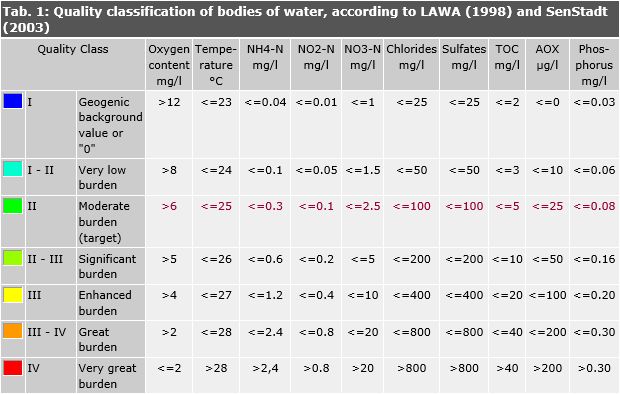For the evaluation of the data from the monitoring of the general chemical-physical condition of the water, the target stipulations based on the LAWA procedure for the chemical classification of bodies of water (LAWA 1998) are used. This classification is used for the parameters oxygen, chloride, sulfate, ammonium nitrogen, nitrite nitrogen, nitrate nitrogen, AOX and TOC, shown on the strip maps. In the developed classification scheme (see Tab. 1), Quality Class I corresponds to the geogenic background value for the substances occurring in nature, such as nutrients and salts, while Quality Class II (target) covers the protection of the biotic aquatic association as well as other criteria for the prevention of water pollution. The other classes have been established by multiplication by a factor of 2.
The actual ecological significance of the parameters varies, sometimes considerably. Oxygen, ammonium and nitrite are important eco-toxicological parameters.
On the other hand, nitrates in the concentrations which occur have no toxic relevance, even for sensitive water organisms. The significance of nitrates lies rather in their function as a nutrient in nitrogen-limited bodies of water. Paradoxically, higher nitrate contents can in fact have an ecologically stabilizing effect. In particular, nitrates as an alternative oxygen supplier can also check the processes of phosphorus re-dissolution at the interface between the sediment and the open water, and hence also check eutrophication.
The classification of chloride, AOX and TOC has more of an indicator role. For instance, chloride concentrations of around 100 mg/l are indeed an expression of anthropogenic influences, but they are ecological quite safe. Sulfates can reach values considerably greater than 100 mg/l, due to either geogenic or anthropogenic causes. In ecological regard, eutrophication-promoting processes are being discussed in connection with higher sulfate values. Sulfates certainly have an additional significance for the drinking water supply in the Berlin area as of Quality Class II-III. For phosphorus, a classification adapted to natural areas has been developed with reference to the eutrophication effect, in comparison with the classification “plankton-dominated streams (LAWA 1996).”
The temperature values were classified according to a Berlin-specific approach for summertime-lowland bodies of water.

